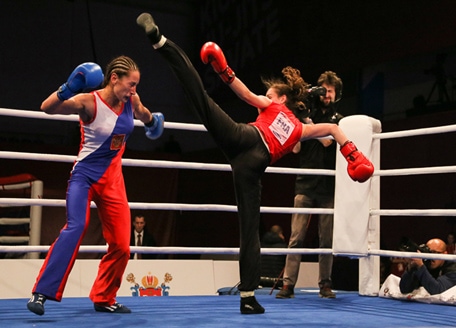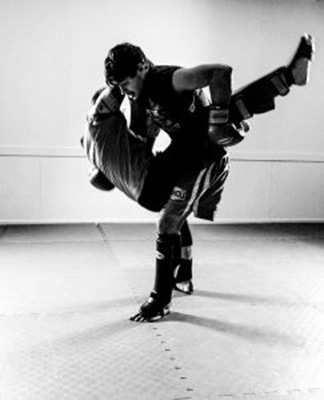In the vast world of MMA, if you were to name a style that uses both a combination of strikes and kicks you may immediately name, Muay Thai, Kickboxing, Karate. You may not Immediately picture French sailors competing at sea… welcome to Savate.
What is Savate?
It goes by many names, French foot fighting, French Boxing, Savate Boxing or Boxe Française; this is a combat sport that uses striking with the hands and feet in a unique hybrid of kicking techniques and English Boxing.
Translated from middle French ‘Savate’ means, old shoe or boot. It is obligatory to wear suitable footwear when training in Savate. The shoes used in Savant are created with purpose as they are utilised for specific techniques. The heel, toe and blade of the shoe are all included in Savate maneuvers.
A Culture Clash
With a history dating back to the early 1800s, the details can be slightly murky when it comes to this martial art. ‘Slipper fighting’ by the name of Chausson or Jeu Marseillais, already existed in the south of France’ which included high kicks to the head. Savate was the title of the street fighting style from northern France, popular among sailors during this period, and lacked any notable rules or regulations.

Source: alchetron.com
That changed in 1838, when French fighter Charles Lecour formalised the art of Boxe-Française Savate. The mythology around this related to an apparent defeat at the hands of a young English boxer named Owen Swift. Given the facts that England and France were at war during the turn of this century, and also geographical neighbours, it’s easy to see how the two counties swapped techniques and Savate was officially born.
By 1924, Savate became a demonstration sport in the Paris Olympics. However the sport did take a dip in popularity for the following few decades in the 20th century. This is likely due to the French casualties in the first and second world war also being skilled in Savate. The global popularity of marital arts in the 1970s included Savate as the sport saw a spike in popularity in France.
By 2000, Savate competitions are heled internationally and the official federation (FISav) have members worldwide. It remains an Olympic sport and is included in the Fédération Internationale du Sport Universitaire (FISU: International University Sports Federation).
Amalgamation of Art Forms
A hybrid of French kicking techniques and English boxing, the sport is practiced by men and women around the world. Unlike Muay Thai, knee and shin strikes are not permitted in Savate, only foot kicks are allowed.
Savate incorporates several types of kicking techniques. Fouetté (a roundhouse kick aimed at the mid-section or head) Chassé (a low side kick), , coup de pied bas (a low kick aimed at the obliques). Foot flexibility is made possible by the boots required.
Savate includes punches from standard English boxing, such jab, cross, hook and uppercut. This combination of techniques creates the fast, graceful battels that require techniques and agility.
Salem Assli is a professor of Boxe Francaise-Savate and a second-degree silver glove, outlines the limitless combinations possibly with these techniques.
“The foot techniques of Savate fall into four categories: low shin, side, roundhouse and reverse. Variations include kicks executed with the lead leg and the rear leg, as well as spinning, jumping and cross-stepping methods. An experienced Savateur can combine those four punches and four types of kicks to form thousands of combinations.”

Source: 2awakeningfighters.com
Kicks often target an opponent's legs, body or head. An opponent's back is a legal target for kicking but not for punches.
This stems from Charles Lecour and his introduction of boxing to the French art. He adopted the rules of the Marquis of Queensbury, which forbade punches to the back, yet obviously had no rules regarding foot strikes’ and non-have ever been created.
Martial In Every Sense
Many devastating combinations in competitions involve a low kick paired with a roundhouse to the body with the tip of the shoe. Feints are also a huge part of Savate. Kicks are generously dished out in competitions and are frequently faked low to a leg before landing elsewhere on the opponent.
These techniques have developed in time in order to distinguish the art form its self-defence, and its street fighting (Savate du Rue) roots, and to add professionalism and credibility to the sport. This created sperate methods of savant that include cane and baton fighting.
Along with the regulation fighting shoes, in official competitions, competitors wear an intégrale or a vest and Savate trousers. They wear boxing gloves (with or without padded palms) and Savate boots.
Contemporary Competitors
Sam Byford-Winter runs Nam Yang Brighton and Brighton Savate. With over 20 years’ experience, numerous competition medals and 30 plus fight record, Sam brings his experience to the British shores as the squads head coach and trains with team GB.
“I already had 14 years training in Kung fu, Tai Chi, Kickboxing, Brazilian Jiu Jitsu, Boxing and came across Savate. I loved the footwork and array of kicks. I really enjoyed watching the technical aspects of Savate. So much of it was based on strategy and technique.”
Due to the many different combinations possible in Savate, partner drills and sparring are key elements of training. “Most important for Savate is movement and being able to put together combinations with your hands and feet whilst constantly changing angles. A lot of good Cardio is needed for Savate as it is quite a high paced combat sport.”

Source: namyangbrighton.co.uk
Sam goes on to explain the effect that this martial art has had on his life. “I spend most days either teaching or training or researching techniques, history etc. It has greatly improved my confidence, fortitude, compassion as well as improvements with my general physicality. It has made me into the person I am today.”
Sam also incorporates the history of the spot into his training and is an advocate for education on the topic. “Part of training is understanding where the art came from and its origin. So for Savate this is France.
It started in both Paris and Marseille and was then formalized into one art called Boxe Francais Savate in the 1800's.” Being such an advocate of the spot, it’s no surprise that Sam wold like to see it become more mainstream. “I would love to see it move into the mainstream Martial Art world, very few people know about it, which is a shame as it is a brilliant system.”
“I think Savate is greatly underestimated and I would love to see it growing more across the world. It is a brilliant art for everyone in terms of anyone can be good, there is an emphasis on technique as opposed to brute force so it’s a great sport to teach kids as they learn control. Plus it is a great form of self-defence. I have had to use my art but more to diffuse the situation as opposed to defending myself.”
Savate Possibly Most Fascinating European Martial Art
A cross breed of combat styles, that combined create a kind of devastation with decorum. Poetry within calculated combinations, designed to deconstruct opponents. Despite its Olympic status, it remains somewhat of a niche art, yet its multifaceted skillset makes this an extremely diverse style of MMA. With schools like Sam’s in the UK, perhaps a resurgence of Savate is in the stars…
